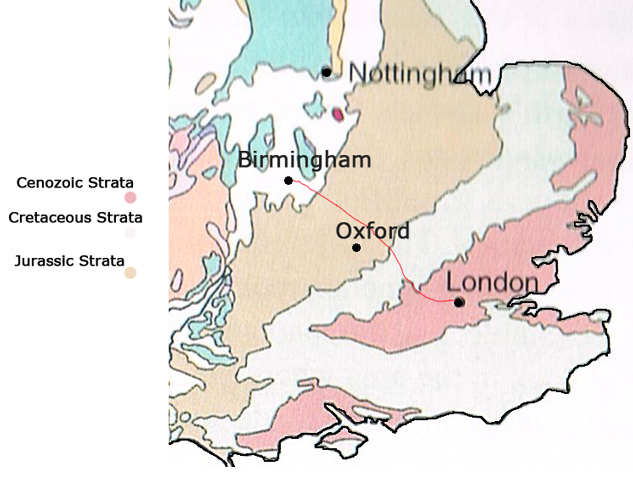A Hidden Benefit of High Speed Rail – Exposing Mesozoic Sediments
London to Birmingham High Speed Rail Link Could Lead to new Fossil Discoveries
The first phase of a new high speed rail route linking London to the West Midlands of the UK is likely to be given the go ahead by the Government today (January 10th). The controversial plan to build a new 100-mile-long, high speed rail link from north-west London through the home counties, up to Birmingham has divided opinion, with supporters keen to see improvements in Britain’s rail infrastructure whilst opponents protest over the cost and the environmental damage the construction may cause. However, the construction work could expose Mesozoic sediments and lead to new fossil discoveries.
Mesozoic Sediments
The Government’s Transport Secretary, Justine Greening will announce that the first phase of this £32 billion project is to go ahead, a second high speed rail plan linking Birmingham to Leeds and Manchester has been proposed and it has been indicated that by 2033 the UK will boast a super fast rail network connecting London with the north of England, enabling trains to travel in excess of 200 mph.
An Illustration of the Proposed Rail Route
Picture credit: Everything Dinosaur
The proposed route takes trains out of north-west London, through the home counties, north of Oxford and on to Birmingham. Supporters say that the new link will alleviate overcrowding, improve the UK’s rail infrastructure and boost the economy by a huge amount. However, opponents are considering legal action in a bid to delay the scheme or to have it postponed altogether.
Cutting Through Cretaceous and Jurassic Strata
The planned rail link will mean that engineers will be cutting through extensive Mesozoic strata, including Jurassic and Cretaceous marine deposits. Just as with the first railways and before them the construction of the canals, this will expose fossiliferous strata, some of it as yet not fully explored and this could lead to scientists making a number of important discoveries.
Following the rail route from London the rocks get older and older. Soon the Tertiary deposits of London and much of the south-east are replaced by a belt of Cretaceous aged rocks, and this gives way to Jurassic aged sediments as the rail link extends northwards. The final part of the first phase of the rail link, the approach to Birmingham will see construction workers creating cuttings and such like through Triassic aged rocks.
If the plans are given the go ahead, an indirect benefit might be the opening up of cuttings and other types of excavation associated with the rail line construction, that could lead to a number of new, exciting fossil discoveries. Perhaps the fossils of marine reptiles might be exposed, or even a dinosaur’s remains, the last resting place of a carcase that was washed out to sea and settled on the seabed more than one hundred million years ago.
We shall wait to see what develops.
In the meantime, for models and replicas of prehistoric animals from the Mesozoic and elsewhere in deep geological time: Prehistoric Animal Models and Dinosaur Replicas.


